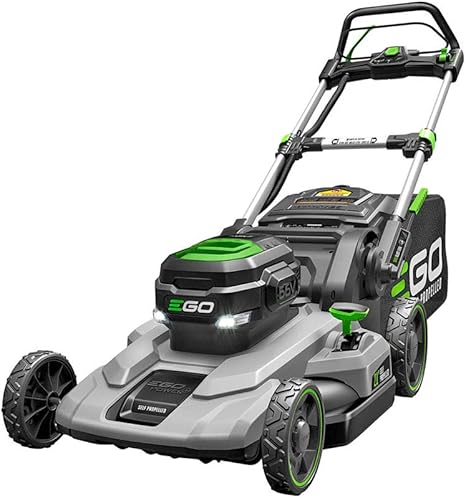Details: EGO Power+ LM2100SP 21-Inch 56-Volt Cordless Self-Propelled Lawn Mower Battery and Charger Not Included
Brand: EGO Power+
Offering the torque of gas without the noise, mess and fumes. The EGO POWER+ 21″ Self-Propelled Mower delivers long-lasting power, rapid charging and durability in all-weather conditions. With up to 60 minutes of cut time when used with the recommended EGO 56V 7.5 Ah ARC Lithium™, this mower tackles even the toughest of mowing applications for all grass types. The adjustable self-propel feature makes mowing effortless. And the easily adjustable deck height enables you to cut at any length. Thanks to a sleek and lightweight construction, moving and storing the lawn mower is hassle-free as it folds compact. Compatible with all of EGO’s ARC Lithium™ batteries; featuring industry-leading technology to deliver superior power.
Advantages
- Products can be returned
- Make sure this fits by entering your model number.
- Up to 60 minutes run time on a single charge when used with the recommended EGO 56V 7.5Ah ARC Lithium
- Variable Speed Self-Propel: .9 MPH – 3.1 MPH
- 6-position cutting height adjustments: 1.5″- 4″
- 3-in-1 function: mulching, bagging, side discharge
Notice
- Is an online purchase
- Delivery may be delayed in some areas.
Buyer Guide Walk-Behind Lawn Mowers
A 3D scanner is a machine that allows objects to be scanned, scanned, and then reconstructed into 3D images.- Laser scanner: This scanner, which works by capturing light, is the most accurate of the three types but is the most expensive.
- 3D camera: This scanner, which uses light, is less expensive but less accurate.
- Projection scanner: This is often the least expensive, but is the least accurate of the three.
- Low-cost scanners: These scanners are often used in education, but aren’t very accurate.
- High-precision scanners: These scanners are the most accurate, but tend to be expensive.
- Speed: Before buying, make sure you understand how quickly the scanner can scan an object.
- Resolution: The resolution of the scanner refers to the number of pixels in the scan.
- Accuracy: Accuracy refers to how close the scan is to the real object.
- Portability: The scanner’s portability refers to how portable it is.
- Cost: The scanner’s cost refers to how much it will cost you to buy.
- Software: Finally, the software that comes with the scanner refers to the type of software you can use.
How to choose Walk-Behind Lawn Mowers
If you work in an engineering group, choosing a 3D scanner can be tricky. There are a variety of different types of 3D scanners available, and choosing one requires a bit of research and consideration.- Magnetic or laser scanning? Magnetic scanning uses a focused magnetic field to create a 3D scan of the object. Laser scanning uses light or other electromagnetic radiation to create a point cloud of the object’s surface.
- What type of data is scanned? Most scanners offer at least one type of data a two-dimensional (2D) height map, a texture map, a point cloud, or a mesh model. When scanning an object with a 3D scanner, you should decide which type of data is the most important to you and your project.
- Do you need to texture your scan? If youre scanning an object with a rough, rough texture, you might not need to create a mesh model. However, if youre scanning an intricate object, such as an intricate piece of jewelry, you might need to create a mesh model of the object.
- How much money can you afford to spend? 3D scanners can cost anywhere from $300 to over $10,000. How much are you willing to spend?
- Do you need to scan an object with a non-planar surface? If the surface of an object is curved, your scanner should be able to scan the object. Most scanners wont scan an object with curved surfaces. Some scanners have a curved surface option so that an object can be scanned in a curved manner.
How to maintain Walk-Behind Lawn Mowers
Before purchasing a 3D scanner, its important to know the basics of maintenance and upkeep.- How often should I clean my 3D scanner? Its always a good idea to regularly clean your scanner, but make sure to follow manufacturer instructions for specifics.
- How long will my 3D scanner last? Many people falsely believe that 3D scanners last for years, but in reality, they need to be replaced after a couple of years. Most 3D scanners have a life expectancy of 3 to 5 years.
- How often should I calibrate my 3D scanner? Many manufacturers suggest calibrating your scanner at least once every month. While some people believe that calibrating your scanner helps to improve its accuracy, this isnt always the case.
- Do I need to calibrate my 3D scanner after performing repairs? Many 3D scanners feature an alignment tool that automatically calibrates the scanner after performing repairs.
- Will software updates fix calibration issues? Many 3D scanners have firmware updates that can fix calibration issues.




